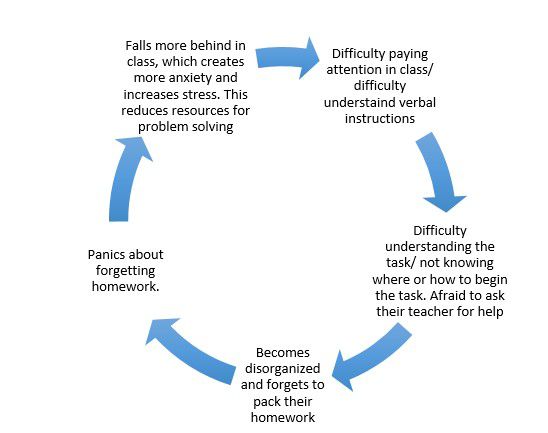Making Sense of the Overlapping Nature of Anxiety, ADHD, and LDs

Many children with Learning Disabilities (LDs) also have co-occurring social-emotional and behavioural concerns such as Anxiety and ADHD. These disorders can often present similarly in children which can make the cause of certain behaviours hard to tease apart. Increased understanding can help guide effective, as well as individualized, accommodations for your child in both the home and school settings.
This article will outline what Learning Disabilities, Anxiety, and ADHD look like separately. Then, the article will look at how they overlap or their similarities. It will then discuss ways to provide support for children who have difficulties across these areas.
Looking at Learning Disabilities, Anxiety and ADHD separately:
It is important to note that LDs, ADHD and anxiety are separate conditions with distinct differences. To understand the overlapping characteristics of LDs, Anxiety, and ADHD, it is helpful to first look at how they present separately before trying to piece together how they overlap. Some distinguishing features include:
Learning Disabilities:
- Academic work is effortful and taxing
- Difficulties with reading, writing, and/or math
- Reduced motivation
- Increased irritability and frustration
- Efforts are not matching academic outcomes
- Embarrassment or noticing they are not achieving at the same rate as their peers
- Lowered self-esteem
- Exhaustion from allocating more cognitive resources to complete tasks, such as academics.
Anxiety:
- Maladaptive thoughts that are typically consumed with fear or worry
- Fears of not performing to the same standards as their peers
- Fear of taking tests
- Procrastination/ difficulty initiating tasks because of perfectionism
- Physiological symptoms such as heart palpitations, sweating
- Can be timid to approach new tasks and situations due to fearfulness
ADHD:
- Brain-based disorder which often impacts executive functions including working memory and emotional regulation
- Difficulty in planning/organizing
- Forgetful in daily activities such as forgets essential material to complete task
- Difficulty starting tasks on their own/with motivation
- Difficulty focusing on one task for extended periods of time
- Difficulty listening to instructions
- Avoids or dislikes tasks that are challenging
- Difficulty understanding social nuances
Understanding the overlap between Anxiety, ADHD, and LDs
Although LDs, ADHD, and Anxiety are separate and distinct disorders, there are some similarities between the three. Teasing apart the disorders can be challenging and confusing. The following chart outlines a few of the common symptoms associated with LD, ADHD and anxiety.
Fidgeting/Restlessness
| Anxiety | Anxious/nervous energy (e.g. pacing, leg shaking, etc.); physiological symptoms (e.g. heart pounding and sweating) |
| ADHD | Brain is not sending signals that help slow down or support the body in not moving. |
| Learning Disabilities | Not following or understanding instructions/ boredom in the classroom which can increase movement. |
Difficulty sustaining attention
| Anxiety | Mind is focused on worries or fears which makes it difficult to maintain focus and sustain attention. |
| ADHD | Difficulty ignoring external stimuli such as sights, noises, peers. |
| Learning Disabilities | Processing speed and working memory overload. If you can’t remember what your teacher said or you are not understanding the task, you can appear inattentive. |
Difficulty finishing school work
| Anxiety | Typically aware of social situation, but have difficulty managing anxious emotions, which can cause difficulties in peer relationships (i.e., fearful to engage). This can give off the impression that the child does not want to interact socially, which can result in the child being excluded from social settings; difficulty following conversations if their mind is consumed with worrying thoughts. |
| ADHD | Difficulty with planning and organization - which can prevent students from handing in their school work on time. |
| Learning Disabilities | Influence of processing speed and working memory; not knowing where/ how to begin; difficulty understanding materials |
Difficulty with friendships and social interactions
| Anxiety | Typically aware of social situation, but have difficulty managing anxious emotions, which can cause difficulties in peer relationships (i.e., fearful to engage). This can give off the impression that the child does not want to interact socially, which can result in the child being excluded from social settings; difficulty following conversations if their mind is consumed with worrying thoughts. |
| ADHD | Difficulty understanding social nuances, as well as the social cues of others; difficulty planning and organizing social events; difficulty processing social conversations; difficulty remembering what others said if not paying attention |
| Learning Disabilities | Difficulty planning and organizing social events; difficulty processing social conversations; difficulty remembering what others said, etc. |
(Source: Houston, 2016; Rosen, 2014-2019; Young, 2019)
Can LDs, ADHD and Anxiety exist together?
Yes, they can! Research suggests that children with Learning Disabilities and/or ADHD are more susceptible to social and emotional difficulties. Here are three examples.
Some challenges include poor academic achievement, which can sometimes make children feel as though they are not achieving as well as their peers. This can impact their self-esteem, which can increase anxious tendencies if protective factors are not put into place. Protective factors can include things such as supportive parents, strong social connections, and extra-curricular activities.
Some research suggests that ADHD symptoms can precede anxiety and vice versa if not treated. For example, a child with ADHD may have difficulty reading social cues, understanding body language, and have difficulty organizing social events, which can lead to the child feeling anxious or nervous in social situations. If this cycle continues, then an anxiety disorder may develop.
A child with a Learning Disability or ADHD may continuously have difficulty meeting deadlines or completing their work, which again, can cause children to be anxious if these patterns persist.

Example adapted from: Houston, 2017
Research suggests that children who have LD or ADHD can sometimes have lower working memory capabilities. Working memory is the ability to hold information in the mind, work with it in some way, and then pull that information from the mind when needed. Often times, working memory is called the “post-it note” of the brain. Challenges with working memory can impact an individual’s ability to organize, problem-solve, and self-regulate. This can make it challenging for individuals to navigate and respond to their environments.
ADHD and anxiety impact working memory in different ways. Both anxiety and ADHD make it difficult to ignore irrelevant stimuli. For example, due to the fear-based nature associated with anxiety, individuals are often more focused on worries (i.e., thoughts are preoccupied with threat). By contrast, for individuals with ADHD, it is typically more challenging to ignore irrelevant stimuli such as sights and noises. In both cases, the anxiety and ADHD use up the child’s working memory capacities which decreases a child’s ability to attend to information. This can negatively impact academic achievement and functioning.
Tips to Help Parents Gather Information to Help Understand their Child’s Struggles:
Having a conversation with your child can help them feel validated and understood. At the same time, this can provide you (the parent) with more insight into your child’s experiences including their strengths and areas of growth. Communication and support is a very important first step. Here are some ideas for potential conversations.
Ask your child what they are thinking or doing when they are distracted. Is your child distracted due to external stimuli (sights, sounds, noise)? Or, are they preoccupied with worries (anxiety)?
Ask your child to explain their social interactions to you. Is your child having difficulty navigating social settings due to fearfulness (i.e., not knowing what to say, fear of being embarrassed, etc.)? Or, are they are having difficulty organizing and planning social events with their friends (ADHD)? Both can have negative consequences on friendships and both scenarios would benefit from different interventions.
Ask your child how you can help them if they are having difficulty starting or completing work. Is your child struggling due to perfectionistic tendencies (i.e., anxiousness)? Or, do they not know where to begin (ADHD/LD)? Each scenario would require a different strategy. For the perfectionist, it will be important to validate their work, acknowledge their efforts, and help normalize their mistakes. For ADHD, it would be helpful to use direct instruction (i.e., breaking down steps into more manageable chunks, etc.)
Why is it important to understand the differences between these disorders?
It is important to understand the differences between LDs, ADHD and anxiety in order to guide effective and individualized treatment.
- Learning Disabilities: Treatments for Learning Disabilities typically focus on specific and direct remedial instruction, as well as classroom accommodations to support academic achievement.
- ADHD: Common treatments for ADHD are the use of stimulant or nonstimulant medications, as well as behavioural strategies and parent training, which do not target the maladaptive thinking associated with anxiety.
- Anxiety: Anxiety interventions typically include anti-anxiety medications and counselling (i.e., CBT, exposure therapy), which often do not target the brain-based problems associated with ADHD.
As you can see, some effective strategies for ADHD might not be effective for anxiety, and what is effective for anxiety, may not be effective for LDs, and vice versa. This highlights the importance of individualized, as well as targeted, interventions, and the importance of consulting with professionals in determining next steps after engaging in the initial conversation points discussed above
Summary
LDs often have co-occurring social, emotional, and behavioural concerns, such as anxiety and ADHD
It is important to understand the difference between LDs, ADHD and anxiety in order to promote optimal functioning
- While LDs, ADHD and anxiety are separate disorders, they can at times look similar and also co-occur together. Children with LDs, ADHD and/or anxiety tend to have difficulties with organization, problem-solving, emotional regulation and working memory.
- Anxiety and Learning Disabilities/ADHD can precede one another and vice versa
- Empathetically talking to your child can help better understand your child’s struggles
- ADHD, LDs, and anxiety can have different treatment pathways.
- A thorough consultation with a professional is important to guide targeted, specific, and individualized treatment pathways.
